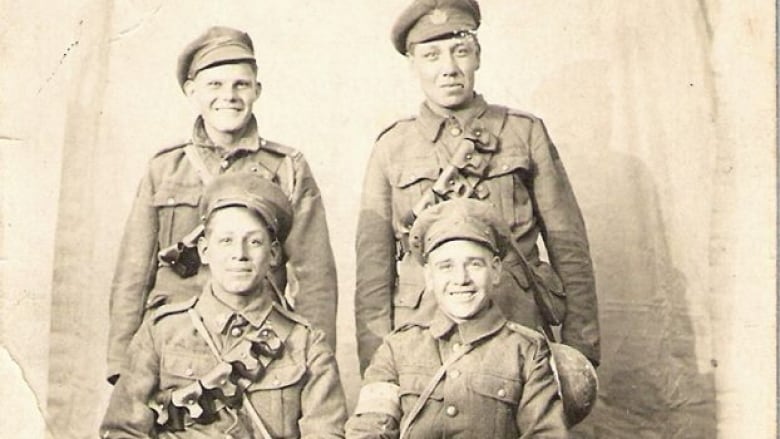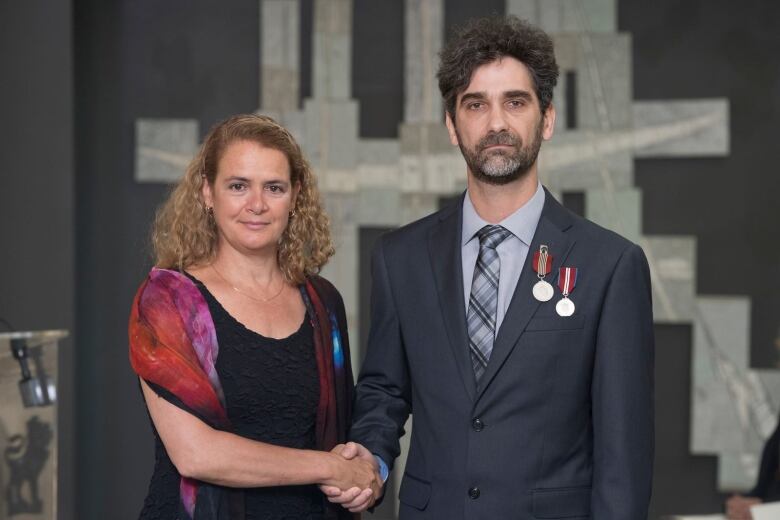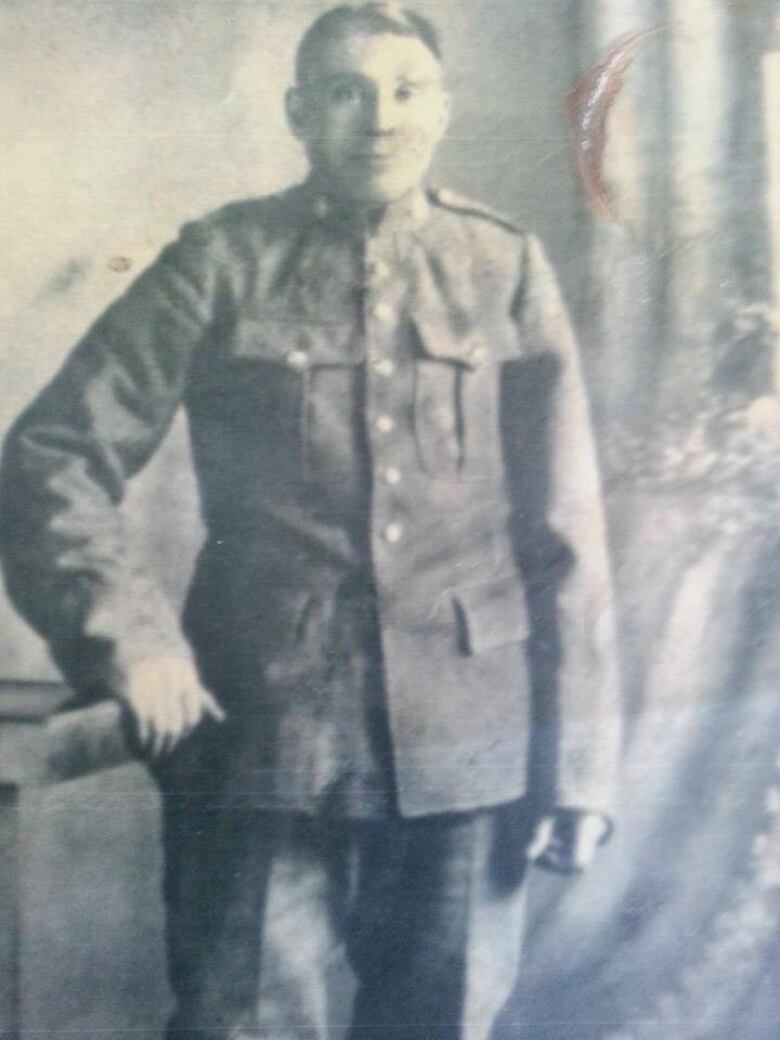Meet the amateur historian who created one of the largest databases of Indigenous soldiers
Yann Castelnot has dedicated years digging into little-known histories

The names of more than 150,000 Indigenous soldiers who fought for Canada andthe United States have been identified after a two-decade effort from a Quebec resident.
YannCastelnot,an amateur historian from France,has compiled one of the largest databases of Indigenous soldiers, including 18,830 who were born in Canada, as a way to learn more about their contributions to Canadian and American forces.
"We forget to say that during modern wars, they massively engaged voluntarily and were brave soldiers respected by their brothers-in-arms," saidCastelnot.
"They must be put back on the altar of heroes alongside all the others, but perhaps this is just the vision of someone a little too passionate."

Castelnotis originally from theVimyregion of Franceand immigrated to Canada 13 years ago. He now lives inRivire-du-Loupon the south shore of the St. Lawrence River.
He has dedicated years to compiling names, photos, and documents on Indigenous soldiers as the president of the Association de recherchedesancienscombattantsamrindiens.
"It's not just a photo or a name, but a story to tell," saidCastelnot.
"We often have a lot of prejudices or misconceptions, but we forget that Aboriginal military participation is an important part of North American history. We forget that there are military and economic alliances with the French, the English, the Americans, the Russians, the Dutch..."
Shedding light on forgotten histories
All information that is discovered by the association is published on its Facebook page, which sometimes includes facts unknown to soldiers' descendants and communities.
LucO'Bomsawin,founding president of the Aboriginal Veterans of Quebec Association, said the database has shed much-needed light on history that's often forgotten or "put aside."

"His work is essential and there's not too many people that did the same kind of work with that dedication," saidO'Bomsawin,anAbenakiveteran fromOdanak, Que.
O'Bomsawinsaid he was surprised by the new informationCastelnotuncovered, such as the number of soldiers who received decorations, and even just the sheer number of soldiersfrom both sides of the border who served in various conflicts.
"We were told different numbers but nobody really had something to base their assumptions on," saidO'Bomsawin.
"With him going through the records and newspapers and whatever he's searched, he managed to change these figures. The figures that he puts on are a lot more serious than what I've seen up to now."
Gaining attention of Veterans Affairs Canada
Castelnot'sefforts earned him a Minister of Veterans Affairs Commendation in 2017, an award givento those who have contributed to the remembrance of the contributions, sacrifices and achievements of veterans.

"The degree of research that he's done and what he's captured in his site seems very significant to us," said Peter Mills, national manager with the commemoration division for Veterans Affairs Canada.
One of the soldiersCastelnothelped bringattention to is Sgt. FrankNarcisseJrome, aMi'kmaqsoldier fromGesgapegiag, Que. He was 29when he volunteered to serve with the Canadian Expeditionary Force in June 1916, and became one of the most decorated soldiers during the First World War.
Jerome saw heavy action in France and Belgium, taking part in major battles at places likeVimyRidge, Hill 70,Passchendaeleand in the series of actions during "Canada's Hundred Days" in the closing months of the First World War.
He is one of only 39 Canadians who received the Military Medal three times during the conflict.
"I insisted for two years to succeed in making it known," saidCastelnot. "It is one of my successes."

WhileJrome'sheadstone can be found in the cemetery inGesgapegiag, and his name also appears on a local war memorial there, his accomplishments are still little known among the community.
"Nobody ever knew anything about this guy," said Al Martin,co-ordinatorof theGesgapegiagHistorical Centre.
"It's such a coincidence because he had his headstone atthe old cemetery;it was just there by itself."
Martin himself only recently became aware of the extent ofJrome'smilitary career while researching a project to make a plaque honouring the three soldiers fromGesgapegiagwho fought in the First World War.
"We had applied for funding to commemorate all the soldiers in our community, but it was just names. I started getting more into it," said Martin.
"Back then, there wasn't too many Natives that got medals for bravery or anything. Like there were people who were shot and were still alive but never got a Purple Heart or those kind of medals.So when Frank's name popped up, I said 'Holy cow!"
Helpingveterans' families
In some of hisresearch, Castelnothas dug deeper into records than even some of the more seasoned researchers in Indigenous military history.
John Moses, a veteran from Six Nations of the Grand River, co-authored A Commemorative History of Aboriginal People in the Canadian Military (2010). HesaidCastelnot'sdatabase is the most extensive he's seen.
"It is certainly a massive undertaking on his part," he said.
Moses has researched extensively intohis own family's service records. His maternal grandmother Edith AndersonMonturewas the first Indigenous woman to volunteer for duty as a nursing sister with the American Expeditionary Force and served two years in France during the First World War.
"In terms of documenting it in my own family's case, we've been fortunate in having just kept things over the years," said Moses.
"We have a number of pieces of original paperwork that we've always had in family hands, but there are a couple of documents here and there that I hadn't seen previously and that he brought to my attention."
Two of those documents were about his paternal great-uncles James, Jesse and Arnold Moses, who were all involved in the Canadian military during the First World War.

"The main thing that Mr.Castelnot'sdatabases has done is shed light onthe much larger numbers of Indigenous people from Canada and the United States who have been involved in military service," said Moses.
ForCastelnot, the work is just a way to share his appreciation of Indigenous Peoples' contributions to Canada and the United States.
"I think that first and foremost it is a question of respect and homage," he said.
"In the end, it's my way of paying tribute to a people that fascinates me."












_(720p).jpg)


 OFFICIAL HD MUSIC VIDEO.jpg)
.jpg)



























































































